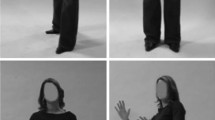Abstract
Preschool-age children drew, decoded, and encoded facial expressions depicting five different emotions. Each child was rated by two teachers on measures of school adjustment. Facial expressions encoded by the children were decoded by college undergraduates and the children's parents. Results were as follows: (1) accuracy of drawing, decoding and encoding each of the five emotions was consistent across the three tasks; (2) decoding ability was correlated with drawing ability among female subjects, but neither of these abilities was correlated with encoding ability; (3) decoding ability increased with age, while encoding ability increased with age among females and slightly decreased among males; (4) parents decoded facial expressions of their own children better than facial expressions of other children, and female parents were better decoders than male parents; (5) children's adjustment to school was related to their encoding and decoding skills and to their mothers' decoding skills; (6) children with better decoding skills were rated as being better adjusted by their parents.
Similar content being viewed by others
References
Ahrens, R. Beitrag zur entwicklung des physionomie-und mimikerkennens 1.Zeitschrift fur angewandte und Experimentelle Psychologie, 1954,2, 414–454.
Bridges, K. M. B. Emotional development in early infancy.Child Development, 1932,3, 324–341.
Buck, R. Nonverbal communication of affect in children.Journal of Personality and Social Psychology, 1975,31, 644–653.
Buck, R. Nonverbal communication of affect in preschool children: Relationships with personality and skin conductance.Journal of Personality and Social Psychology, 1977,35, 225–236.
Charlesworth, W. R. Persistence of orienting and attending behavior in infants as a function of stimulus-locus uncertainty.Child Development, 1966,37, 473–491.
Charlesworth, W. R., & Kreutzer, M. A. Facial expressions of infants and children. In P. Ekman (Ed.),Darwin and facial expression. New York: Academic Press, 1973.
Cowen, E. L., Dorr, D., Clarfield, S., et al. The AML: A quick-screening device for early identification of school maladaptation.American Journal of Community Psychology, 1973,1, 12–35.
Cunningham, M. R. Personality and the structure of the nonverbal communication of emotion.Journal of Personality, 1977,45, 564–584.
Dashiell, J. F. A new method of measuring reactions for facial expressions of emotions.Psychological Bulletin, 1927,24, 174–175.
Dougherty, F. E., Bartlett, E. S., & Izard, C. E. Responses of schizophrenics to expressions of the fundamental emotions.Journal of Clinical Psychology, 1974,30, 243–246.
Ekman, P., & Friesen, W. V.Unmasking the face. Englewood Cliffs, N.J.: Prentice-Hall, 1975.
Ekman, P., Friesen, W. V., & Ellsworth, P.Emotion in the human face: Guidelines for research and an integration of findings. New York: Pergamon Press, 1972.
Fulcher, J. S. “Voluntary” facial expression in blind and seeing children.Archives of Psychology, 1942,38, 1–49.
Gates, G. S. An experimental study of the growth of social perception.Journal of Educational Psychology, 1923,14, 449–461.
Goodenough, F. L.Measurement of intelligence by drawings. Yonkers, N.Y.: World, 1926.
Hall, J. A. Gender effects in decoding nonverbal cues.Psychological Bulletin, 1978,85, 845–857.
Honkavaara, S. The psychology of expression.British Journal of Psychology Monograph Supplements, 1961,32, 1–96.
Hunt, W. A. Recent development in the field of emotion.Psychological Bulletin, 1941,38, 249–276.
Izard, C. E.Face of emotion. New York: Appleton, 1971.
Kellog, R.Analyzing children's art. Palo Alto, Calif.: National Press Books, 1969.
Kwint, L. Ontogeny of mobility of the face.Child Development, 1934,5, 1–12.
Lorion, R. P., Cowen, E. L., & Caldwell, R. A. Normative and parametric analyses of school maladjustment.American Journal of Community Psychology, 1975,3, 293–301.
Odom, R. D., & Lemond, C. M. Developmental differences in the perception and production of facial expressions.Child Development, 1972,43, 359–369.
Peiper, A.Cerebral function in infancy and childhood. New York: Consultants Bureau, 1963.
Spitz, R. A. Ontogenesis: The propleptic function of emotion. In P. H. Knapp (Ed.),Expression of the emotions in man. New York: International Universities Press, 1963, pp. 36–60.
Spitz, R. A., & Wolf, K. M. The smiling response: A contribution to the ontogenesis of social relations.Genetic Psychology Monographs, 1946,34, 57–125.
Valentine, C. W. The innate bases of fear.Journal of Genetic Psychology, 1930,37, 394–420.
Watson, J. B.Psychology from the standpoint of a behaviorist. Philadelphia: Lippincott, 1919.
Wilcox, B., & Clayton, F. Infant visual fixation on motion pictures of the human face.Journal of Experimental Child Psychology, 1968,6, 22–32.
Zuckerman, M., Hall, J. A., DeFrank, R. S., & Rosenthal, R. Encoding and decoding of spontaneous and posed facial expressions.Journal of Personality and Social Psychology, 1976,34, 966–977.
Zuckerman, M., Lipets, M. S., Koivumaki, J. H., & Rosenthal, R. Encoding and decoding nonverbal cues of emotion.Journal of Personality and Social Psychology, 1975,32, 1068–1076.
Reference notes
Kreutzer, M. A., & Charlesworth, W. R.Infants' reactions to different expressions of emotions. Paper presented at the Society for Research in Child Development, Philadelphia, March 1973.
Hall, J. A.Gender effects in encoding nonverbal cues. Unpublished manuscript, The Johns Hopkins University, 1978.
Hall, J. A., & Halberstadt, A. G.Sex roles and nonverbal communication skills. Unpublished manuscript, The Johns Hopkins University, 1978.
Author information
Authors and Affiliations
Additional information
The authors gratefully acknowledge the assistance of the Greater Rochester Jewish Community Center, Early Childhood Department, and the parents of the participating children in the completion of this study. Special thanks to Sandra Walter, Director of the Early Childhood Department, for her cooperation and support during all stages of the project.
Rights and permissions
About this article
Cite this article
Zuckerman, M., Przewuzman, S.J. Decoding and encoding facial expressions in preschool-age children. J Nonverbal Behav 3, 147–163 (1979). https://doi.org/10.1007/BF01142589
Issue Date:
DOI: https://doi.org/10.1007/BF01142589




